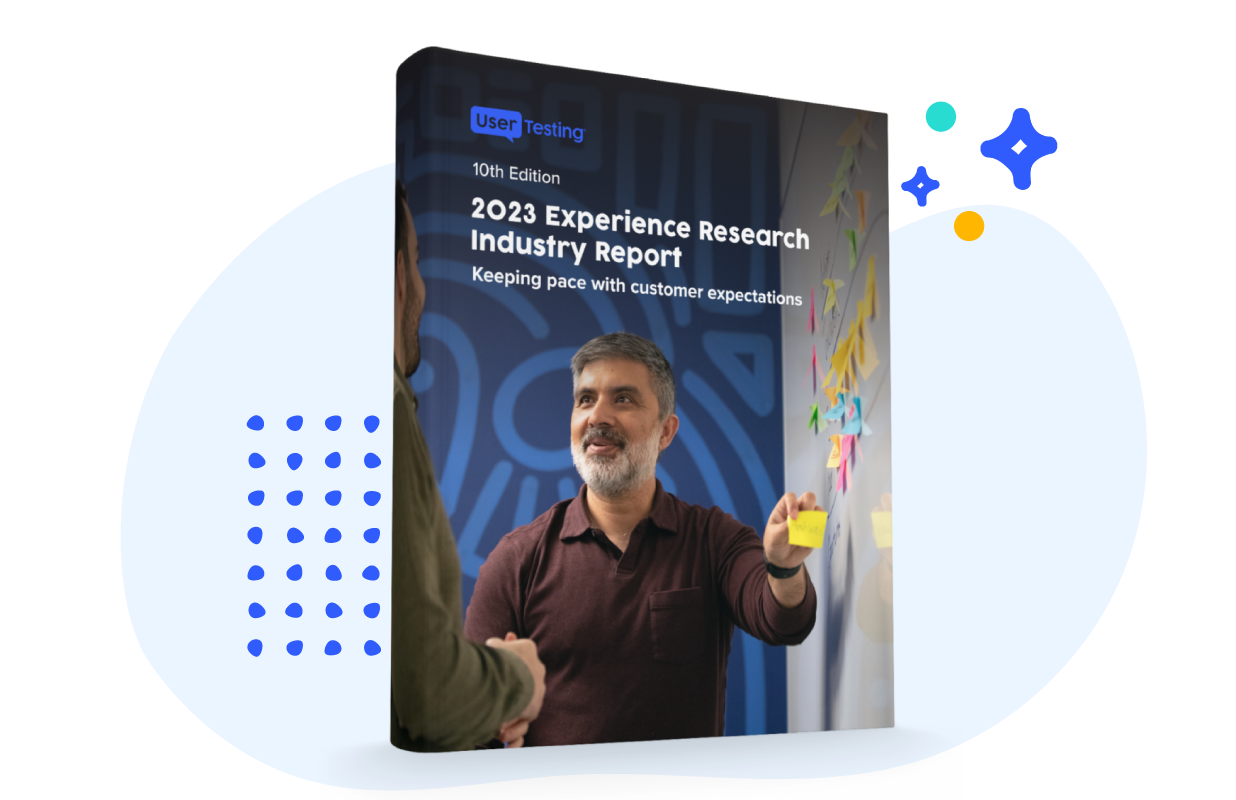
How to empower your team with UX metrics

So, you’ve decided to start measuring the user experience of your products. Your next step is sharing the metrics in a way that's transparent, understandable and empowering for your team.
The impact of sharing UX metrics with your team and stakeholders around the business can be hard to measure, but that doesn’t mean you’re not having an impact. To help with this issue, we’ve put together a list of six actions to inspire you on how to use your UX metrics within your team and six impacts these can have on your way of working.
Action #1: Invite engagement in research
Research can be labor-intensive, so you want to make the most of the opportunities you have with users.
One key impact you can have with your research is by inviting others within the business to watch user stories unfold before their own eyes. This way, it’s a lot harder to ignore the issues!
Inviting others to see user research will help them to gain interest in the metrics you use, and interviews will help them understand individual users' behavior.
In addition, those who are involved in and understand the metrics have a bigger picture of what is going on with users. This insight should also enable them to dig deeper into findings.
Action #2: Provide clear and digestible insights
When you first start measuring UX it can be daunting, especially if your product or service has been live for some time.
This is because you’re likely to discover many issues all at once. If your Product Owners or Developers seem overwhelmed by the metrics or they’re not what everyone hoped for, then tell the story behind the metric rather than the numbers on their own.
It’s great to have a central research repository for transparency, but it’s important to make sure people don’t run with the metrics before they understand them!
It’s also worthwhile clarifying responsibility for the metrics and offering support to anyone who may not understand their impact. It is so easy to look at data visualization and make your mind up on what it means.
For example, low time spent on a page may look like limited engagement, but it also may mean that the experience is supporting users in being efficient in their tasks.
On the flip side, a high engagement metric through an activity like clicking may look positive, but for some pages, it may show that users are struggling to find what they need.
Action #3: Make metrics accessible
The most empowering metrics are the most accessible. Developers and Product Owners can’t use metrics they can’t see.
One good way is to start sharing simple metrics which are interesting even if they’re not key measures. For example, you could share funny or interesting user feedback - this way your team will become interested in what users are saying.
Try to start with positive metrics to boost morale and set the scene that metrics don’t always have to be ‘resolved’ in some way.
Once you have piqued your team’s interest in what users have to say, share the bigger picture of how they are affecting Objective Key Results (OKRs) or how findings are influencing upcoming designs.
It helps to share insights at times where you have their attention, such as the end of Sprint Demos. Fill the team in on how the feedback has been over the last sprint, pulling out both what users are asking for and what they liked. Even if they don’t take in all of the metrics, by providing transparency in feedback on their work, you’re helping to build trust between disciplines.
Remember to stress that individual insights are not sufficient evidence to base decisions on and that the whole picture should be taken into account. Use user insights responsibly!
Action #4: Monitor your metrics long-term
With UX metrics, we talk about identifying the business goal to get everyone on the same page, which is a great first step.
However, goals can and do change, frequently and quickly, and especially in an agile environment!
Metrics help shape the UX roadmap when they are continuously monitored rather than looked at for a few weeks at a time. Monitoring metrics over time will help uncover whether you’re on the right path, and when or whether you need to change direction.
No one metric will have the answer to a problem. Using a combination of metrics provides you several ideas of the directions to take with your projects.
Frameworks for using metrics are also helpful when using a combination of metrics. For example, UserTesting has their QXscore, a UX measurement score that combines users’ attitudinal and behavioral data into a single number and identifies opportunities to improve.
The metrics in this QXscore aim to measure the quality of the overall user experience. You can use this score as a way of measuring progress for business OKRs and then reevaluate whether the roadmap is on track for what users want and need, and what the business wants to achieve.
Action #5: Plan the story, not the metrics
There are a lot of metrics that you can monitor and with each metric comes a cost of collection. They are a means to an end, not necessarily the end themselves.
Make sure you’re analyzing the metrics that are relevant to a specific goal or purpose within the team or business. If not, you’ll be collecting data for no reason, or you won’t know what to do with the findings.
Used in isolation, metrics, and user insights can be confusing for other teams. It’s important to explain that individual pieces of data or research don’t represent every user and must be used responsibly.
Action #6: Invite others to champion a user’s voice
Acquiring buy-in for user experience from the business down through development can be difficult at times.
User-centered design can take a lot of work, but we can ease conversations and tensions when discussing designs by inviting other disciplines to champion the users.
Once others have been a part of the research you can start to invite them into the conversation to share their thoughts and suggestions based on what they have seen users do.
Let’s say you are advocating for a design that is already the minimum viable product but developers are really questioning whether it’s worth the effort.
Perhaps they want to strip the feature down even more, but you know that will make it less user-friendly and efficient. In cases like this, if you have a product owner who has been involved in the metrics or a developer who has seen just one interview, you can start to ask them to refer back to what they’ve seen.
You’ll be surprised how this insight can solve these tensions and provide a product or developer’s point of view to the user goal and your design.
Impact #1: Improve team morale by showcasing the impact of their work
Sharing metrics in a way that means people understand the story and how they contribute to the bigger picture can positively impact team morale.
Being a designer means we are spoiled with feedback on our work, whether it’s the good, the bad, or the ugly. Not many other roles experience the same.
Great feedback can inspire the team to keep going and offers validation in the sweat and tears that have gone into the thousands of lines of code. Even the not-so-great feedback can help the team to learn and grow.
Impact #2: Solve non-design problems that users face
A user experience is affected by so many things that are out of designers’ hands. Non-functional requirements like performance, accessibility and offline support heavily depend on the way it is coded.
But if no one is accountable for a metric, how is it evaluated? Well, designers can’t be the only ones responsible for all these metrics.
A study by Google shows that the bounce rate increases by 90% if the page takes between one and five seconds to load. Developers are up against a mountain of factors that impact performance, and may not know the full impact that poor performance is having on the business.
We as designers should be monitoring this because it hugely impacts the user experience, but ultimately developers are the ones who are going to be fixing the issue. Provide a starting point by sharing the current loading times as an initial benchmark and what the team should be aiming towards.
Impact #3: Insights are championed by different disciplines
A user’s experience is impacted by anyone who is involved with the product, so it shouldn’t just be designers who champion the user’s voice.
Inviting others into research sparks a new fire in people. You’ll often find those who have been involved in research will refer back to the sessions they’ve seen in other meetings.
For example, Developers can refer to the high bounce rate to ask for the budget to tackle the performance problems that may have been in the backlog for months. In addition, marketing can use the language they see in user feedback to inform the copy of their newsletters and tweets, etc.
Impact #4: Collaboration across disciplines on designs
When other disciplines have an enriched understanding of users, it’s much easier to share a common goal, that of creating a positive user experience. User experience is affected by technical and product decisions just as much as design decisions. Providing opportunities to collaborate on designs will allow you to bring more metrics and insights into the conversation to help shape the way people approach a problem.
Let’s say you are designing a file merging tool. The system should inform the user when files are similar and they need the ability to merge more than two files at a time, both online and offline.
This is complicated from a design perspective and technically challenging. For example, How do users deem files to be duplicated? How can we automatically detect duplicates? How can merge conflicts be avoided when working offline and returning online?
Conversations often need to include the technical details which will impact the interface. Of course, designers will champion users and developers will promote technical perspectives.
However, collaborating when everyone is armed with user metrics and aims for the same goal is so empowering. Conversations flow easier, and ideas and sketches better represent what the solution needs to be.
Impact #5: Broaden research from metrics to strategy
Your UX metrics are now measuring the success of goals, uncovering usability issues and influencing your roadmap.
At this point, hopefully, you will have also streamlined your research operations with metrics being owned by specific people. Your teams are collaborating, user problems are being fixed and the user experience is being improved.
All these improvements are going to open doors for research to play a part in the business vision. Sure, we set the tone of the products or services, we influence the roadmap but the next level is helping shape the strategy for the business. Having better organization and streamlining UX activities shows off the capabilities and maturity of a design team.
The maturity of UX is still improving in the industry on a daily basis with businesses slowly coming round to the idea of being user-centric and allowing what their users are saying to define designs. Not all design teams or companies have had the chance to mature to this level, but when you do, it will be magical.
By having people leading on metrics, you’re putting designers out there for other disciplines to come to. Empowering your team and the business in small ways adds up and helps you build the rapport and reputation for design to be invited into C-Level discussions.
Impact #6: Better user feedback on live products
Overall, your user experience will improve because of these empowered conversations and collaborations.
The final user experience is representative of a combination of user needs and technical and business needs. This should translate into a user-friendly product that people want to use. Tagging feedback, for example from interviews, surveys and forums will help you keep track of the general feeling of the product from users.
In summary
There may be a steep learning and setup curve, but UX metrics can help shape a lot of aspects of the business. This includes the maturity of the design team within your company, the shape of the roadmap and the end-user experience.
Even if the curve is steep, it is worth the effort. Using your metrics is just as important as collecting your metrics, with the effects reaching far and wide throughout the business.






